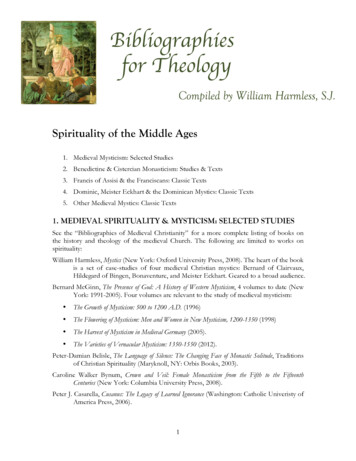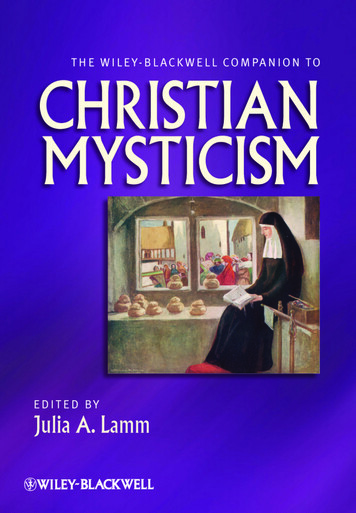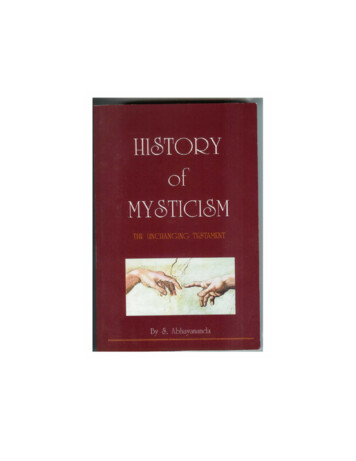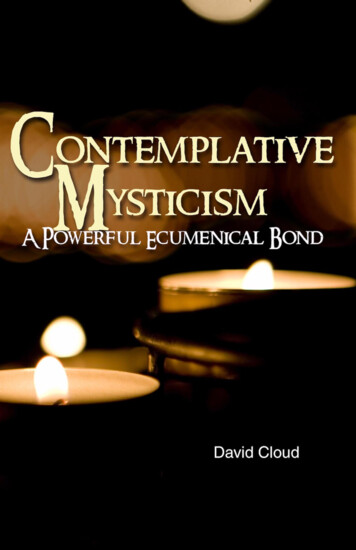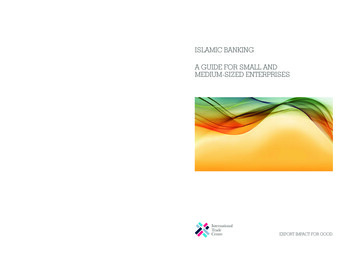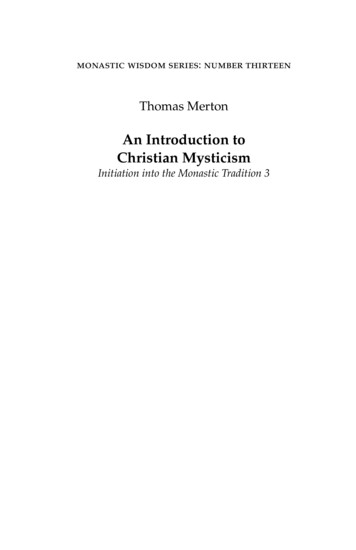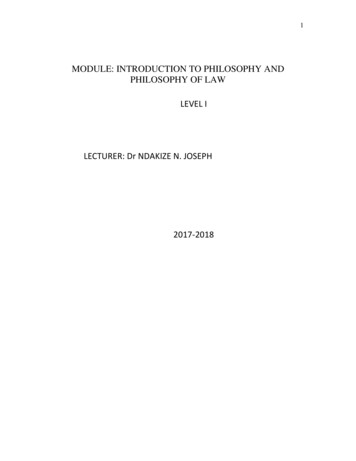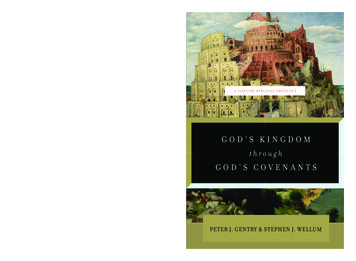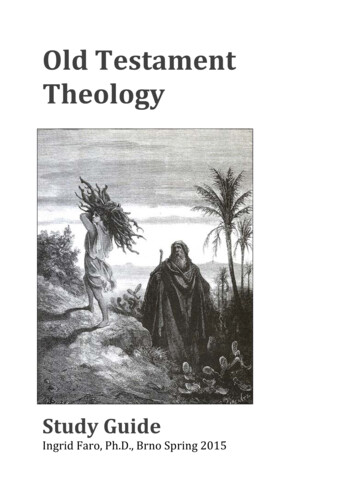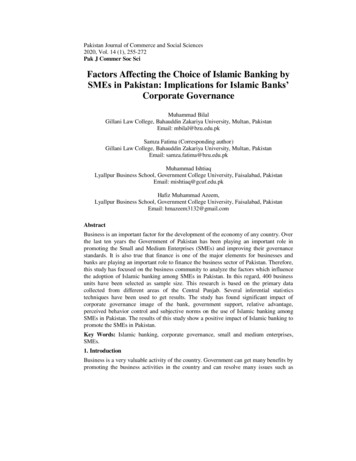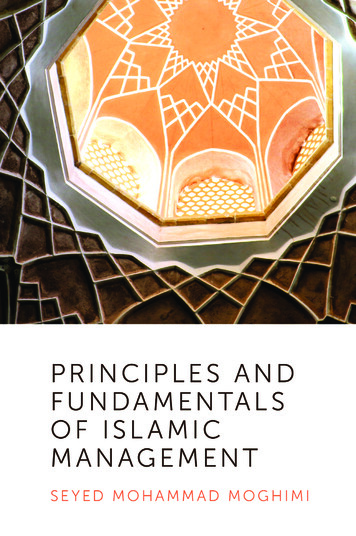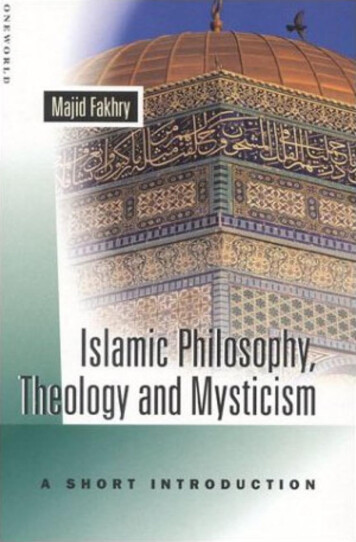
Transcription
IslamicPhilosophy,TheologyandMysticismA SHORT INTRODUCTION
OTHER BOOKS IN THIS SER I ESBuddhism: A Short Introduction, Klaus K. Klostermaiser, ISBN 1–85168–186–8Buddhism: A Short History, Edward Conze, ISBN 1–86168–211–XHinduism: A Short History, Klaus K. Klostermaier, ISBN 1–85168–213–9Hinduism: A Short Introduction, Klaus K. Klostermaier, ISBN 1–85168–220–1Islam: A Short History, William Montgomery Watt, ISBN 1–85168–205–8Muhammad: A Short Biography, Martin Forward, ISBN 1–85168–131–0Jesus Christ: A Short Biography, Martin Forward, ISBN 1–85168–172–8Christianity: A Short Introduction, Keith Ward, ISBN 1–85168–229–5Judaism: A Short History, Lavinia and Dan Cohn-Sherbok, ISBN 1–85168–206–6Judaism: A Short Introduction, Lavinia and Dan Cohn-Sherbok, ISBN 1–85168–207–4A Short Reader in Judaism, Lavinia and Dan Cohn-Sherbok, ISBN 1–85168–112–4A Short Introduction to the Old Testament Prophets, E. W. Heaton, ISBN 1–85168–114–0Sufism: A Short Introduction, William C. Chittick, ISBN 1–85168–211–2The Bahá’í Faith: A Short History, Peter Smith, ISBN 1–85168–070–5The Bahá’í Faith: A Short Introduction, Moojan Momen, ISBN 1–85168–209–0Confucianism: A Short Introduction, John and Evelyn Berthrong, ISBN 1–85168–236–8Global Philosophy of Religion: A Short Introduction, Joseph Runzo,ISBN 1–858168–235–XPluralism in the World Religions: A Short Introduction, Harold Coward,ISBN 1–85168–243–0Scripture in the World Religions: A Short Introduction, Harold Coward,ISBN 1–85168–244–9RELATED TITLES PUBLISHE D BY ON EWORL DWhat Muslims Believe, John Bowker, ISBN 1–85168–169–8The Qur’án and its Exegesis, Helmut Gätje, ISBN 1–85168–118–3The Faith and Practice of Al-Ghazálí, William Montgomery Watt, ISBN 1–85168–062–4On Being a Muslim, Farid Esack, ISBN 1-85168-146-9Revival and Reform in Islam, Fazlur Rahman, edited and with an introduction byEbrahim Moosa, ISBN 1–85168–204–XQur’án, Liberation and Pluralism, Farid Esack, ISBN 1-85168-121–3
IslamicPhilosophy,TheologyandMysticismA SHORT INTRODUCTIONMajid Fakhry
I S L A M I C P H I L O S O P H Y, T H E O L O G Y A N D M Y S T I C I S M :A SHORT INTRODUCTIONOneworld Publications(Sales and Editorial)185 Banbury RoadOxford OX2 orld Publications(US Marketing Office)160 N. Washington St.4th Floor, BostonMA 02114USA Majid Fakhry 1997Reissued 2000All rights reservedCopyright under Berne ConventionA CIP record for this title is availablefrom the British LibraryISBN 1-85168-252-XCover design by Design DeluxePrinted and bound in England by Clays Ltd, St Ives plcNL08
CONTENTSPrefaceixIntroduction116THE TRANSMISSION OF ANCIENT PHILOSOPHY AND SCIENCEThe Greek and Syriac LegaciesThe Persian and Indian Legacies2EARLY RELIGIOUS AND POLITICAL CONFLICTSThe Political Scene in the Seventh CenturyThe Rise of Systematic Theology (Kalam)The Five Fundamental Principles of the Mu‘tazilah3THE DAWN OF SYSTEMATIC PHILOSOPHY AND FREE THOUGHTIN THE NINTH CENTURYAl-KindiAbu Bakr al-RaziThe Progress of Free Thought4NEOPLATONISM AND NEOPYTHAGOREANISM IN THE TENTHAND ELEVENTH CENTURIESAl-FarabiIbn SinaThe Brethren of Purity69111113152121293438384754
vi X Islamic PhilosophyA S H O R T I NTRODUCTI ONThe Diffusion of Philosophical Culture in the TenthCentury5678INTERACTIONS OF PHILOSOPHY AND DOGMA63The Eclipse of Theological RationalismThe Islamic Assault on Neoplatonism6368PHILOSOPHY AND MYSTICISM73Ascetic BeginningsPantheistic or Unitary MysticismInteractions of Mysticism and Neoplatonism737577THE RESURGENCE OF PERIPATETIC PHILOSOPHY INAL-ANDALUS85The Beginnings of Philosophical Speculation inal-AndalusIbn BajjahIbn TufaylIbn Rushd85THE PROGRESS OF ANTI-RATIONALISM AND THE ONSET OFDECLINEIbn Hazm and Ibn TaymiyahFakhr al-Din al-Razi and his SuccessorsIbn Khaldun of Tunis and his New Philosophy of History960ILLUMINATIONISM (ISHRAQ) AND THE RECONCILIATION OFNEOPLATONISM AND SUFISMAl-SuhrawardiAl-Shirazi (Mulla Sadra) and his Successors10 MODERN AND CONTEMPORARY TRENDSIslamic Thought in India–Pakistan and South-East AsiaThe Continuity of the Ishraqi Tradition in PersiaModernism and Fundamentalism in the Muslim WorldToday879093101101104107113113116123123127129
CONTENTSX viiConclusion139Appendix One The Chief Philosophical Translations143Appendix Two Leading Mu‘tazilite Scholars146Select Bibliography148Index154
PREFACEThe purpose of the present volume is to introduce the reader to philosophy, theology and mysticism as they developed and interacted inthe Islamic context. This development over a period of almost elevencenturies may be said to have reached its zenith in the tenth and eleventhcenturies, which also witnessed the most violent confrontations.However, in a serious narrative or analysis it is necessary to trace thisdevelopment and interaction from beginning to end, rather than stop, assome historians of Islamic philosophy and theology have done, at thefourteenth or fifteenth century.Throughout the discussion, I have tried to exhibit the relation of philosophy, by which theologians and mystics were influenced or againstwhich they reacted, to its Greek and Hellenistic origins, as well as itseventual transmission across the Pyrenees to Western Europe in thetwelfth and thirteenth centuries. That, I believe, is essential for demonstrating its continuity, its affiliation to the great intellectual movementsin world history and its significance as an ingredient in world culture.The reader who wishes for a more detailed discussion of the basicconcepts and movements referred to in this book should consult myHistory of Islamic Philosophy, second edition, 1983 and my Philosophy,
x X Islamic PhilosophyA S H O R T I NTRODUCTI ONDogma and the Impact of Greek Thought in Islam, 1994. I haveattempted in the present volume to highlight the major philosophical,theological and mystical concepts and the problems with their interrelations in a succinct but adequate way, without bothering the reader withlengthy analyses and references. The Select Bibliography at the end of thebook will give the reader a fair idea of the vast literature on the subject inArabic and Western languages.Finally, in transliterating Arabic proper names or technical terms, Ihave, with minor variations, followed the system of the Encyclopaedia ofIslam. The translations of Qur’anic passages and other Arabic sources inthis book are all mine, with very few exceptions.Majid FakhryWashington DC
INTRODUCTIONThe history of philosophy, which saw the light on the shores of theEastern Mediterranean in the sixth century BCE, was marked fromthe start by the urge to ask the most searching questions about nature,human beings and God. That is how philosophy spawned in time themajor sciences of physics, ethics, mathematics and metaphysics, whichcontinue to be the building-blocks of world culture.From Western Asia Minor, philosophy crossed the Aegean Sea intomainland Greece and, for a thousand years, Athens became its home.When Alexandria was founded by Alexander the Great in 332 BCE,philosophy began its eastward migration, which was virtually completedin 529 CE. In that year, the Byzantine Emperor Justinian ordered theSchool of Athens to be closed owing to its pagan sympathies which, asdefender of the Orthodox faith, Justinian regarded as a threat toChristianity. Seven of its most illustrious teachers, led by Damascius(d. 553) and Simplicius (d. 533), made their way across the borders intoPersia, where they were well received by Chosroes I (Anushirwan), agreat admirer of Greek philosophy and science. Around the year 555 hefounded the School of Jundishapur, an important centre of Hellenicstudies and medical research.
2 X Islamic PhilosophyA S H O R T I NTRODUCTI ONIt was at Alexandria, however, rather than Jundishapur, that Greekphilosophy was to undergo its most radical transformation. From apurely indigenous product of the Greek genius, it now became thoroughly cosmopolitan, with profound religious and mystical leaningsalmost unknown to the classical Greeks. Thus, the names we associatewith Alexandrian or Hellenistic philosophy are those of Plotinus(d. 270), Porphyry of Tyre (d. 303) and Jamblichus (d. 330), who formulated a new brand of philosophy, designated as Neoplatonism, in whichall the major currents of classical Greek philosophy, Platonism,Aristotelianism, Pythagoreanism and Stoicism were brought together inan imposing synthesis.When Egypt was conquered by the Arabs in 641, Alexandria was stillflourishing as a centre of Greek philosophy, medicine and science, as wellas a Hellenized form of Christian theology which had a decisive impacton Muslim philosophy and theology, as will appear in due course. As aninstance of this historic development, we note that the cultural scenebegan to shift eastwards, first to Damascus in the Umayyad period (661–750) and subsequently to Baghdad, during the ‘Abbasid period (750–1258).As the first scene of Muslim–Christian encounter, Damascus witnessed during the seventh and eighth centuries the stirrings of a new spiritof enquiry, born of political strife as well as theological controversy. Infact, the first stirrings of this spirit took a distinctly political, and oftentragic, form. Because of the close correlation in Islam between the spiritual realm of religion and the temporal realm of politics, the earliest theological controversies between the Qadaris, or advocates of free will, andthe traditionalists, or advocates of divine predestination, revolvedaround the question of political accountability. Did the UmayyadCaliphs have the right to carry out the most repressive policies or perpetrate the most heinous crimes with total impunity, since their actionswere all decreed by God? Qadari theologians like Ma‘bad al-Juhani(d. 699) and Ghaylan al-Dimashqi (d. 743) challenged those arbitraryclaims and asserted the responsibility of the Caliphs, as well as theirlowliest subjects, for their unjust deeds.As controversy grew over questions of free will (qadar), divine justiceand the meaning to be attached to the Divine Speech in the Qur’an, theologians felt a growing need to turn to philosophy in general, and logic inparticular, for the refinement of their concepts or methods of proof.However, a certain antipathy to Greek philosophy, because of its pagan
I NTRODUCTI ONX 3or foreign extraction, began to surface in theological quarters. Muchlater, even the most skilled theologians, who had come thoroughly underthe influence of Greek philosophy, such as al-Ghazali (d. 1111), reactedviolently against it on religious grounds.Nevertheless, philosophy could boast, almost from the start, the enthusiastic support of a galaxy of distinguished scholars or authors, who assimilated and continued the legacy of their Alexandrian predecessors, withPlotinus at their head. They were fascinated by that philosopher’s obsession with the concept of the unity and transcendence of the Supreme Beingwho generates, by an effortless process of emanation, the descending orderof beings, starting with the Intellect, or Nous, and ending with the materialworld. The Soul, or Psyche, which emanates from the Intellect, dominatesand animates the material world. After passing through a series of incarnations, it is fated to return to its original abode in the intelligible world onceit has been cleansed of its earthly impurities and discovered its true identityas a citizen of that intelligible world.What fascinated the Muslim philosophers, once they were exposed tothis Neoplatonic worldview, was its profound religious and mysticalpathos, especially its concept of the utter transcendence of the SupremeBeing and the noble destiny it reserved for the soul in the higher world.No wonder, therefore, that the first phase in the development of Muslimphilosophy was predominantly Neoplatonic. However, both in philosophical and theological circles, this brand of Greek philosophy waschallenged before long and a variety of other more complex systems wereproposed as substitutes. Thus al-Kindi (d. c.866), who still stands on theborderline between philosophy and theology, was as anxious to defendthe Qur’anic worldview as he was the Greek; al-Razi (d. c.925) is farcloser in outlook to Plato than to Plotinus; and others, like Ibn Rushd (d.1198), regarded Aristotle as the paragon of wisdom or the First Teacher.Despite their community of purpose in the pursuit or elucidation ofreligious truth, the philosophers and theologians (mutakallimun) soonfound themselves at loggerheads; the Aristotelian worldview, with its twinprinciples of causality and the uniformity of nature which ‘does nothing invain’, as Aristotle had put it, appeared to the theologians to be inimical tothe Qura’nic worldview. According to this, God can effect His designs inthe world imperiously and miraculously without any impediments orrestraints upon His unlimited power. Nor is He answerable for any of Hisactions, as the philosophers had argued in the name of divine wisdom orjustice. It was for these reasons that from the tenth century the theologians
4 X Islamic PhilosophyA S H O R T I NTRODUCTI ONadopted an ‘occasionalist’ metaphysics of atoms and accidents. Thisaccorded well, they believed, with the Qur’anic concept of God’s omnipotence and His sovereignty in the world, for it belonged to God alone tocreate or recreate the atoms and accidents which made up physical objectsin the world and to cause them to cease as He pleased and when Hepleased.The pursuit of religious piety was identified from the earliest timeswith the strict observance of the precepts of the Shari’ah, or Holy Law, aslaid down in the Qur’an and the Traditions of the Prophet Muhammad(Hadith). However, as early as the seventh century pious souls began topreach asceticism and renunciation of the world, beautifully exemplifiedin the lives of al-Hasan al-Basri (d. 728) and his followers, especially thegreat woman mystic, Rabi‘ah al-‘Adawiyah (d. 801). This asceticism wasdestined to lead in due course to Sufism, whose ultimate goal was to seeka direct channel of communication with God, either through vision orcontemplation (mukashafah), as al-Junayd (d. 911) and al-Ghazali werelater to claim, or through union (ittihad). This was the ultimate goal ofthe extravagant Sufis, such as al-Bistami (d. 875) and al-Hallaj (d. 922).The philosophical component in Sufism is best exhibited in the pantheistic system of Ibn ‘Arabi (d. 1240) and the Ishraqi philosophers of Persiasuch as al-Suhrawardi (d. 1191) and al-Shirazi (d. 1641), who broughtNeoplatonism and Sufism into harmony for the first time in Muslimhistory.Following its flowering in the East during the tenth and eleventh centuries, philosophy received its major reverses at the hands of Ash‘arite,Hanbalite and Literalist theologians and scholars. However, it soongained a new lease of life in the western parts of the Muslim empire,al-Andalus or Arab Spain, from a galaxy of brilliant Neoplatonic andAristotelian philosophers such as Ibn Bajjah (d. 1138) and Ibn Rushd(d. 1198). In Persia, Ishraq marked a turning-point in the development ofphilosophy and Sufism and once more demonstrated the resilience ofphilosophy.Prior to modern times, when philosophy was completely Europeanized, so to speak, the great moments in philosophy’s history were theGreek-Hellenistic, the Arab-Islamic and the Latin-Christian. Followingthe fall of the Roman Empire in 476, Greek philosophy was almost completely forgotten in Western Europe, while it continued to flourish in theMuslim world. It is not sufficiently realized by most students of thehistory of philosophy in the Middle Ages that the ‘Little Renaissance’ in
I NTRODUCTI ONX 5thirteenth-century Europe was triggered by the Latin translations of thewritings of al-Farabi, al-Ghazali (called Algazel), Ibn Sina (Avicenna),Abu Ma‘shar and Ibn Rushd (Averroes), with the consequent revival ofAristotelianism, the cornerstone of Latin scholasticism. In that respect,Arab-Muslim Spain served as the bridge across which Islamic philosophy, science and medicine crossed into Western Europe, thanks to thecontribution of the great translators of the twelfth and thirteenth centuries: Gerard of Cremona, Johannes Hispanus, Dominicus Gundissalinus,Michael the Scot, Hermannus Alemannus and others, who hailed fromall the corners of the European continent.In the East, despite reverses throughout the thirteenth and fourteenthcenturies, Islamic philosophy was able to rise from its ashes. In its Ishraqiform, it continued to be taught in the religious seminaries of Meshhed,Najaf and Qom, as well as the major universities, and it is still the subjectof research and publication in Iran. In the Middle East, the teaching ofphilosophy was revived in Egypt by al-Afghani (d. 1897) and Muhammad ‘Abduh (d. 1905) and continues today to be part of the educationalcurricula in most Middle Eastern and Arab countries, including Egypt,Syria, Lebanon, Jordan, Kuwait and Iraq. Research and publications inphilosophy, whether Islamic or European, have proliferated during thiscentury, as illustrated by the works of ‘Abd al-Rahman Badawi, JamilSaliba, Ibrahim Madkour, Zaki Nagib Mahmud, Hossein Nasr andmany others.
1THE TRANSMISSION OFANCIENT PHILOSOPHYAND SCIENCETHE TRANSMISSION OF ANCIENT PHILOSOPHYAND SCIENCETHE GREEK AND SYRIAC LEGACIESWith the capture of Alexandria in 641, the Arab conquest of theMiddle East was virtually complete. Greek culture had flourishedin Egypt, Syria and Iraq since the time of Alexander the Great. Thecapture of Alexandria, which had become the cultural centre of theancient world, brought the Arabs into contact with the cultures of Greeceand the Middle East; for during the Ptolemaic period Alexandria hadbecome the heiress of Athens in the fields of philosophy and science.In addition, it had become the meeting-ground of Greek speculativethought and oriental religious and mystical traditions, Egyptian, Phoenician, Persian, Jewish and Christian. The chief product of this Greek–Oriental encounter was Neoplatonism, founded by the Egyptian Plotinus (d.270) and his most famous disciple the Syrian Porphyry of Tyre (d. 303).This brand of late Greek philosophy may best be described as a brilliantattempt to bring together the major currents in classical Greek thought,Platonic, Aristotelian, Pythagorean and Stoic, interpreted or recast in
T H E TR A N S MI S SI ON OF ANCI ENT PHI LOSOPHY AND SCI ENCEX 7oriental religious or mystical idiom. It is not surprising, in the circumstances, that this should capture the imagination of Arab-Muslim philosophers, as illustrated by the fact that the first major philosophical text tobe translated into Arabic, probably from Syriac, was a paraphrase of thelast three books (IV, V and VI) of Plotinus’ great work, the Enneads. Thiswork was compiled by Porphyry and divided into six books of nine chapters each (hence its name, which means ‘nine’ in Greek). In Arabic,however, the paraphrase in question was called the Athulugia, (Theology) or the Kitab al-Rububiyah (Book of Divinity) and was erroneouslyattributed to Aristotle by its translator, ‘Abd al-Masih Ibn Na‘imah ofEmessa (d. 835). Although its Greek author is unknown, learned opiniontoday inclines to regard it as the work of Plotinus’ disciple and editor,Porphyry himself.Apart from Alexandria, centres of Greek linguistic, grammatical andtheological studies flourished throughout Northern Syria and Upper Iraqwell into the seventh and the eighth centuries. Of these centres, we mightmention Antioch, Harran, Edessa, Qinnesrin and Nisibin, whereSyriac-speaking scholars concentrated on the translation into Syriac oftheological works written in Greek and emanating from Alexandria. As apropaedeutic or introductory text to the study of these works, parts ofAristotelian logic, including the Isagoge of Porphyry, the Categories, theHermeneutica and the first parts of the Analytica priora, were translatedinto Syriac, excluding thereby the Analytica posteriora, the Sophistica andthe Topica, which were deemed dangerous from a Christian point of view.Logical and theological studies at these centres continued uninterrupted following the Arab conquest of Syria and Iraq, and producedeminent Jacobite and Nestorian scholars, such as Severus Sebokht(d. 696), Jacob of Edessa (d. 708), Georgius, known as Bishop of theArabs (d. 774), and others.However, translation from Syriac or Greek into Arabic appears tohave started in the eighth century. The classical sources credit theUmayyad prince Khalid Ibn Yazid (d. 704) with sponsoring the translation of medical, alchemical and astrological works into Arabic. The firstaccredited philosophical translations, however, are those attributed tothe great literary author ‘Abdullah Ibn al-Muqaffa‘ (d. 759) or his sonMuhammad, consisting of the Categories, the Hermeneutica and theAnalytica priora of Aristotle, probably from Pahlavi, during the reign ofthe ‘Abbasid Caliph al-Mansur (754–73).More important, perhaps, are the translations of Plato’s Timaeus in
8 X Islamic PhilosophyA S H O R T I NTRODUCTI ONGalen’s synopsis or summary of that great Dialogue, Aristotle’s Deanima, the Book of Animals, Analytica priora and the apocryphal Secretsof Secrets (ascribed to Aristotle), undertaken by Yahia Ibn al-Bitriq(d. 815) during the reign of Harun al-Rashid (786–809). However, it wasHarun’s second son, al-Ma’mun (813–33), who placed the translation ofGreek and foreign works in philosophy, science and medicine on an official footing. A brilliant and enlightened Caliph, al-Ma’mun founded theHouse of Wisdom in Baghdad in 830 to serve as a library and institute oftranslation, headed upon its founding by Yuhanna Ibn Masawayh (d.857) and shortly after by his disciple, Hunayn Ibn Ishaq (d. 873), thegreatest figure in the whole history of philosophical and medicaltranslation.Among the most important philosophical works which Hunayn, hisson Ishaq, his nephew Hubaysh and his disciple ‘Isa Ibn Yahia, working asa team, are credited with translating were Aristotle’s Analytica posteriora,the Synopsis of the Ethics by Galen, as well as the synopses of Plato’sSophist, Parmenides, Politicus, the Republic and the Laws. Aristotle’s Categories, Hermeneutica, Generation and Corruption, the NicomacheanEthics and parts of the Physics, together with the spurious De plantis, weretranslated from Syriac by Ishaq Ibn Hunayn; whereas the Metaphysics wastranslated by, among others, a little-known translator, Astat (Eustathius)and Yahia Ibn ‘Adi (d. 974). Other parts of the Physics were translatedfrom Greek by Qusta Ibn Luqa (d. 912), who is also credited with thetranslation of the Generation and Corruption and the pseudo-Plutarch’sPlacita philosophorum. Abu Bishr Matta (d. 940) and his disciple, YahiaIbn ‘Adi, the translator of the Metaphysics, are credited with numeroustranslations, mostly from Syriac. These included the Rhetoric and thePoetics of Aristotle, which were included in the Aristotelian logical corpusknown as the Organon in the Arabic and Syriac traditions. Al-Hasan IbnSuwar (d. 1017) and Abu ‘Uthman al-Dimashqi (d. 910) are two of thebetter-known late translators of logical and philosophical texts.As already mentioned, the translator of the paraphrase of Plotinus’ lastthree Enneads was Ibn Na‘imah of Emessa. This paraphrase, erroneouslyattributed to Aristotle, laid the foundations of Arab-Islamic Neoplatonismand was commented upon by a number of Islamic philosophers, includingal-Kindi, al-Farabi and Ibn Sina, who never questioned its Aristotelianauthorship. Other pseudo-Aristotelian works translated into Arabicinclude the already-mentioned De plantis and the Secret of Secrets, as wellas the Book of Minerals and the Liber de causis. Referred to in the Arabic
T H E TR A N S MI S SI ON OF ANCI ENT PHI LOSOPHY AND SCI ENCEX 9sources as the Pure Good, the last-mentioned book was a compilation ofthirty-two propositions selected from the Elements of Theology written bythe great Neoplatonist Proclus of Athens (d. 485) and translated anonymously into Arabic prior to the tenth century. It played an important rolein the development of the emanationist worldview first elaborated by1al-Farabi and his Neoplatonic successor, Ibn Sina.THE PERSIAN AND INDIAN LEGACIESThe massive effort to translate the chief monuments of Greek philosophy,science and medicine into Arabic, thanks to the patronage of the early‘Abbasid Caliphs and a cluster of other patrons, like the Barmakids, theBanu Shakir and the Banu Musa, introduced Muslims to the whole cultural heritage of the Greeks. However, Plato’s Dialogues reached them inan abridged form, of which very few samples or excerpts have survived inArabic. The Politics was the only major work of Aristotle never to betranslated into Arabic. It was replaced instead by a spurious and superficial treatise purporting to have been written by Aristotle for the use of hispupil, Alexander the Great. Known as the Secret of Secrets, this treatisewas translated by Yahia Ibn al-Bitriq (d. 815), who claimed to have discovered it in a ‘Greek temple’, during his travels in ‘Bilad al-Rum’, or Byzantium. In addition, a smattering of information about the Pre-Socraticstrickled down through secondary sources such as Porphyry’s lost Historyof Philosophy and pseudo-Plutarch’s Placita philosophorum, and has beenpreserved in such doxographies as al-Milal wa’l-Nihal of al-Shahrastani(d. 1153) and the Suwan al-Hikmah of al-Sijistani (d. 1000). Of thosePre-Socratics, the names of Pythagoras and Empedocles, whose religiousleanings are well known, recur constantly, but the names of Thales,Parmenides and Heraclitus are barely mentioned in the sources.The interest of Muslim scholars in other cultures, such as the Indianand Persian, did not match their interest in Greek culture, and Romanculture remained virtually a closed book to the Arabs. Interest in Indianculture tended to turn on astronomical and medical subjects, but it is significant that the religious beliefs of the Indians were not totally ignored.Thus, Ibn al-Nadim (d. 995), the great bibliographer, refers in his Fihristto a tract ‘On the Creeds and Religions of India’ which was in circulationin his day and of which he saw a copy in al-Kindi’s own hand. He also1.See appendix 1 for a list of major translations from Greek and Syriac.
10 X Islamic PhilosophyA S H O R T I NTRODUCTI ONrefers to other tracts on which he says he based his account of the religious creeds of the Indians. Our major source of information on the religious and philosophical beliefs of the Indians, however, is contained inthe writings of al-Biruni (d. 1048), the great astronomer and historian,who expounded with great perspicacity, in his Tahqiq ma li’l-Hind minMaqulah (The Truth about the Beliefs of the Indians), the fundamentalbeliefs of the Hindus, for which he finds apt parallels in Greek philosophy. In this book al-Biruni refers, moreover, to a little-known writer ofthe ninth century, Abu’l-‘Abbas al-Iranshahri, who was particularlyconversant with Indian religious doctrines and who appears to haveinfluenced the great philosopher-physician Abu Bakr al-Razi (d. 925),especially in his concepts of space and time and the atomic compositionof bodies. Some aspects of Indian atomism appear, in fact, to have been atthe basis of the atomism of Kalam, one of the cornerstones of Islamictheology.If we turn now to the Persian legacy, we find that it consisted primarily of the literary and moral lore of the ancient Persians. The earliestexample of the literary lore is Kalilah wa Dimnah, or ‘Fables’ of theIndian sage Bidpai, translated from Pahlavi by Ibn al-Muqaffa‘ (d. 759).Equally important is the compilation known as Jawidan Khirad, or ‘Eternal Wisdom’, written more than two centuries later by a fellow-Persian,Miskawayh (d. 1030), the greatest ethical philosopher of Islam. It consists, according to the author, of all that he was able to glean ‘of thesermons and moral teachings of the four nations; I mean the Persians, the2Indians, the Arabs and the Greeks’.The first part of this compilation consists of aphorisms and sermonsof the prehistoric Persian king Ushahang (Hoshang), Buzurgimhr,Anushirwan, Bahman the King and others. It is noteworthy, however, thatthe most profound Persian influence stemmed from the religious doctrinesof Manicheeism, which had an all-pervasive influence on poets, philosophers and politicians, including some Caliphs. Our sources mention,among those accused of Manicheeism, known in Arabic as zindiqs, oradepts of the Zend Avesta (the sacred scriptures of Zoroastrianism), thepoet Bashshar Ibn Burd, Abu ‘Isa al-Warraq, members of the Barmakidfamily, Ibn al-Muqaffa‘ and the Umayyad Caliph Marwan II.2.Miskawayh, Jawidan Khirad, pp. 5f.
2E A R LY R E L I G I O U S A N DPOLITICAL CONFLICTSTHE POLITICAL SCENE IN THE SEVENTH CENTURYThe translations discussed in chapter 1 were a major factor in thedevelopment of Muslim philosophical and theological thought.However, their impact was not felt at once and it was not until the eighthand ninth centuries that they begin to play a decisive role in theologicalcontroversies. Political conflicts, though, began to play an important rolein shaping the theological outlook of rival parties as early as the seventhcentury.The first serious issue to split the Muslim community following thedeath of the Prophet in 632 CE was the question of the legitimate successor to the caliphal office. This came to a head in the wake of the assassination of the third Caliph, ‘Uthman Ibn ‘Affan, in 656. This act pittedagainst each other the two claimants to the caliphate, ‘Ali Ibn Abi Talib,son-in-law of the Prophet, and Mu‘awiyah, Governor of Damascus andkinsman of the assassinated Caliph.According to the traditional account, as ‘Ali’s army was about tosnatch the fruit of victory from Mu‘awiyah at the Battle of Siffin in 657,Mu‘awiyah resorted to a delaying tactic and called for arbitration. Thearb
OTHER BOOKS IN THIS SERIES Buddhism: A Short Introduction, Klaus K. Klostermaiser, ISBN1-85168-186-8 Buddhism: A Short History, Edward Conze, ISBN 1-86168-211-X Hinduism: A Short History, Klaus K. Klostermaier, ISBN 1-85168-213-9 Hinduism: A Short Introduction, Klaus K. Klostermaier, ISBN 1-85168-220-1 Islam: A Short History, William Montgomery Watt, ISBN 1-85168 .
